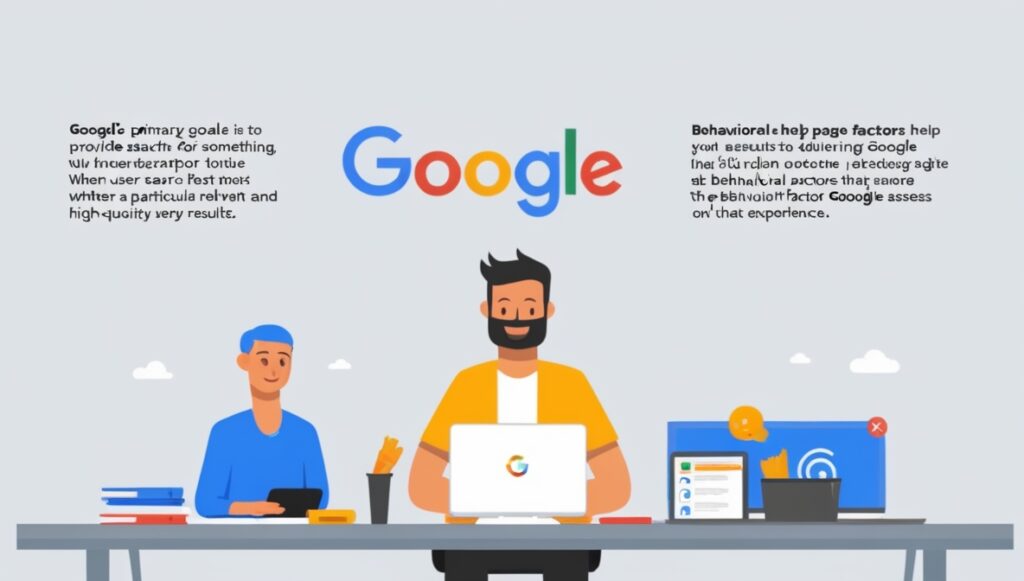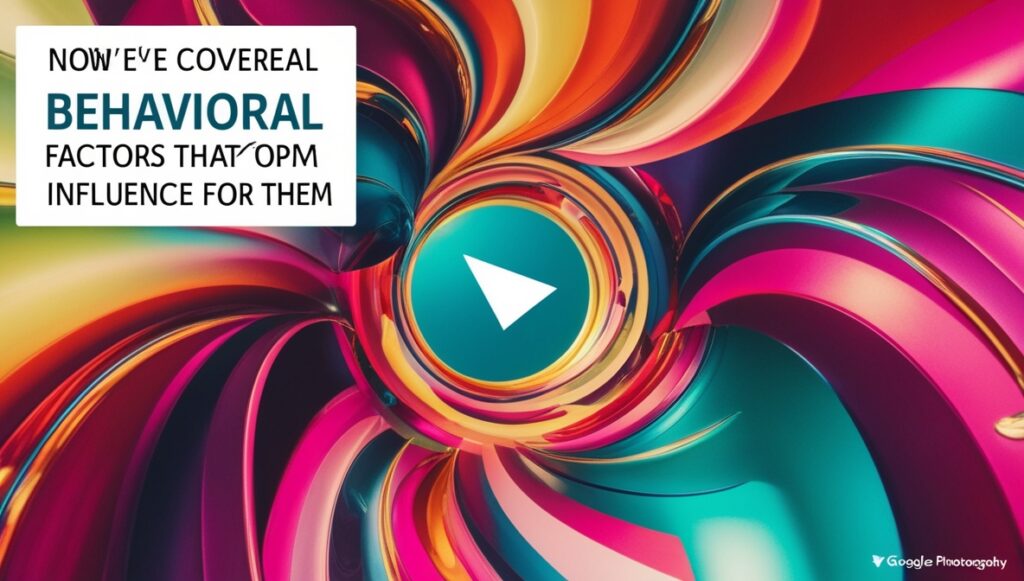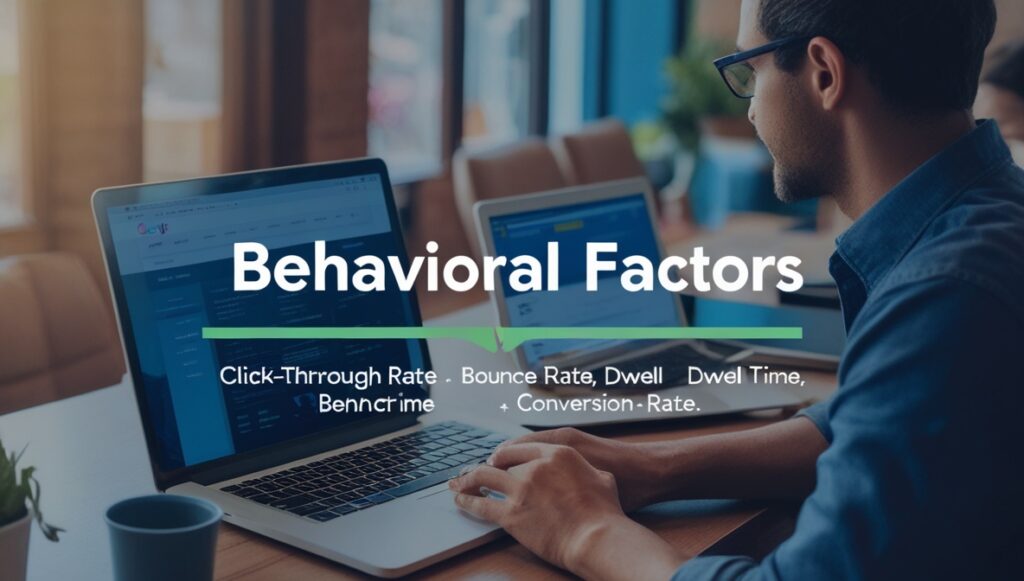
In the fast-evolving world of digital marketing, SEO is a critical element in driving traffic, generating leads, and boosting sales. For businesses like Dust Digital Marketing Ltd., attracting potential customers hinges on optimizing not only for keywords but also for a range of other factors, including behavioral factors SEO Google.
But what are behavioral factors, and why do they matter so much for SEO? In this article, we will break down the importance of behavioral factors SEO Google, discuss how they influence search rankings, and provide insights on how you can optimize for these elements to improve your website’s performance on Google.
What Are Behavioral Factors in SEO?

Behavioral factors in SEO refer to the actions and behaviors of users when they interact with a website. Google and other search engines use these factors to determine the quality and relevance of web pages. By analyzing how users engage with content, search engines can assess the value of the site and adjust its position in search results accordingly.
It’s important to note that Google’s algorithm is complex and multifaceted. It’s simply a set of programs that are constantly updated to rank web pages in the organic listings in a consistently fair manner. The user behavior data that Google relies on includes click-through rate, duration on the web page, conversion rate, bounce rate, frequency of visits, the channel of navigation, and more.
In simple terms, behavioral factors are signals that indicate how satisfying and engaging your website is for visitors. When users find a site helpful and stay longer or interact more, it sends positive signals to Google, boosting the site’s ranking.
Why Behavioral Factors Matter for Google SEO

Google’s primary goal is to provide the best possible user experience. When a user searches for something, Google wants to deliver the most relevant and high-quality results. Behavioral factors help Google assess whether a particular page is delivering on that promise.
For example, if users click on a search result, spend a significant amount of time on the page, and navigate through other parts of the website, it shows Google that the site is providing valuable content. Conversely, if users quickly leave the page after clicking on it (high bounce rate), it suggests that the content didn’t meet their expectations, which can lead to a lower ranking.
Key Behavioral Factors That Impact Google Rankings

To optimize for behavioral factors, it’s essential to understand the specific metrics that Google tracks. Let’s explore the most important behavioral factors that impact your Google rankings:
1. Click-Through Rate (CTR)
Click-through rate (CTR) refers to the percentage of users who click on your website link after seeing it in search results. A high CTR indicates that your website is attracting users with relevant titles, meta descriptions, and content that match their search intent.
Google considers a high CTR as a positive signal because it means that users find your result compelling and relevant to their query. To improve your CTR, focus on crafting engaging and accurate meta titles and descriptions that encourage users to click.
2. Dwell Time and Session Duration
Dwell time refers to how long a user stays on a webpage after clicking on it from the search results before returning to the search engine. Closely related is session duration, which is the total time a user spends on your website during a single visit.
Both of these metrics provide insight into how engaging and relevant users find your content. If a visitor quickly leaves your page, it signals to Google that the content may not be useful or engaging enough. In contrast, a long dwell time or session duration indicates that users find your content valuable, which can positively impact your rankings.
3. Bounce Rate
Bounce rate is the percentage of visitors who leave your website after viewing only one page, without interacting or navigating further. A high bounce rate is often seen as a negative behavioral signal, as it suggests that users did not find the information they were looking for or did not find it engaging enough to explore further.
However, bounce rate should be considered in context. For example, a high bounce rate may not always be bad if users are finding the answer they need on a single page. Nonetheless, improving page engagement by offering related content or clear calls to action can help lower your bounce rate and improve SEO.
4. Conversion Rate
Conversion rate refers to the percentage of visitors who complete a desired action on your website, such as making a purchase, signing up for a newsletter, or downloading a resource. A high conversion rate signals to Google that users find your website useful and trustworthy, which can positively influence your rankings.
To optimize your conversion rate, focus on creating a seamless user experience, with clear calls to action and optimized landing pages. Understanding your audience’s pain points and addressing them with relevant content will also help improve conversion rates.
5. Return Visitors and Frequency of Visits
Google values websites that have a high number of return visitors and frequent visits. If users are coming back to your site repeatedly, it indicates that they find your content useful and engaging, which is a positive signal for SEO.
To encourage return visits, regularly update your content, provide valuable resources, and build a strong community around your brand. Incorporating user engagement tools like newsletters, blog subscriptions, and social media integration can help boost the frequency of visits.
6. Pogo-Sticking
Pogo-sticking is a term used to describe the action of a user clicking on a search result, then quickly returning to the search results page to click on a different result. This behavior suggests that the first website did not satisfy the user’s search intent, which can hurt that website’s ranking.
To minimize pogo-sticking, ensure that your content accurately addresses the user’s query. Providing clear, concise answers and maintaining high-quality content that aligns with search intent is key to keeping users on your page and engaged.
7. Social Signals and User Engagement
Although there is debate about the direct impact of social signals on Google’s rankings, there is evidence that user engagement from platforms like Facebook, Twitter, and Instagram can indirectly influence SEO. Content that is shared widely on social media can generate traffic and backlinks, both of which can improve search rankings.
Encouraging users to share your content and engage with it on social media platforms can help increase visibility, drive traffic, and send positive behavioral signals to Google.
How to Optimize for Behavioral Factors SEO Google

Now that we’ve covered the main behavioral factors that influence SEO, the next step is understanding how to optimize for them. Here are some practical strategies to improve your website’s behavioral factors and boost your Google rankings:
1. Improve Your Content Quality
Quality content is the foundation of a successful SEO strategy. Ensure your content is well-researched, informative, and addresses the search intent of your audience. Use engaging formats like videos, infographics, and interactive elements to keep users on your page longer, reducing bounce rates and improving dwell time.
2. Optimize for User Experience (UX)
A smooth and intuitive user experience is essential for keeping visitors on your site. Ensure your website is mobile-friendly, loads quickly, and has a clean, easy-to-navigate design. Use internal linking to guide users through your content and keep them engaged.
3. Craft Compelling Meta Titles and Descriptions
Your meta title and description are the first things users see in search results. Make sure they are clear, concise, and accurately reflect the content of your page. Use power words and emotional triggers to entice users to click on your link.
4. Encourage Engagement and Social Sharing
Incorporate social sharing buttons on your content to encourage users to share your articles, videos, or other materials. The more engagement your content generates, the more likely it is to drive traffic, which in turn can improve your rankings.
5. Use Clear CTAs and Lead Magnets
Guide users through your website with clear calls to action (CTAs). Whether it’s making a purchase, signing up for a newsletter, or downloading a free resource, providing clear next steps can improve conversion rates and reduce bounce rates.
Conclusion

Behavioral factors play a critical role in determining your website’s ranking on Google. By understanding and optimizing for metrics like click-through rate, bounce rate, dwell time, and conversion rate, you can enhance the user experience on your website, sending positive signals to Google’s algorithm.
Dust Digital Marketing Ltd. specializes in helping businesses improve their SEO by leveraging the power of behavioral factors. Our comprehensive SEO services focus on optimizing user engagement, driving traffic, and increasing conversion rates, all while aligning with Google’s ever-evolving ranking factors. Contact us today to learn more about how we can help your business thrive in the digital space.
By focusing on these strategies, you can not only improve your SEO rankings but also enhance the overall user experience, leading to more satisfied customers and higher conversion rates.

